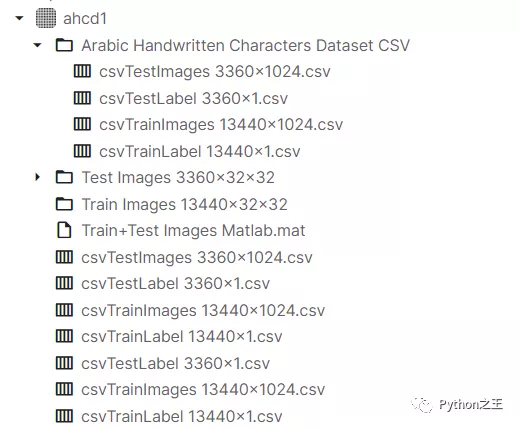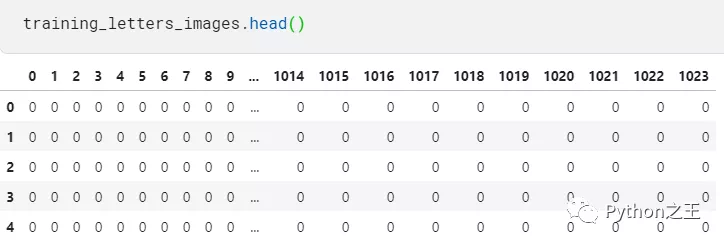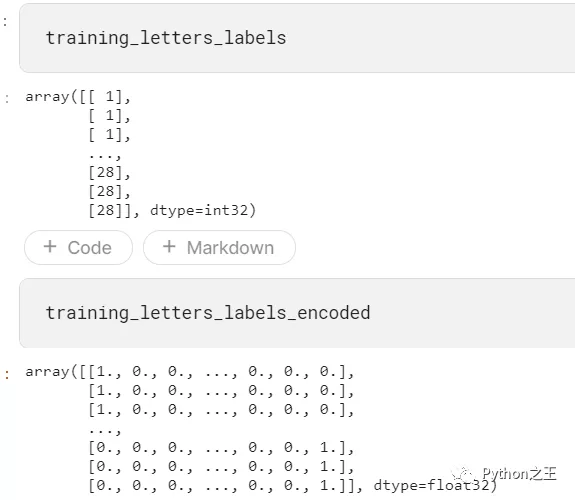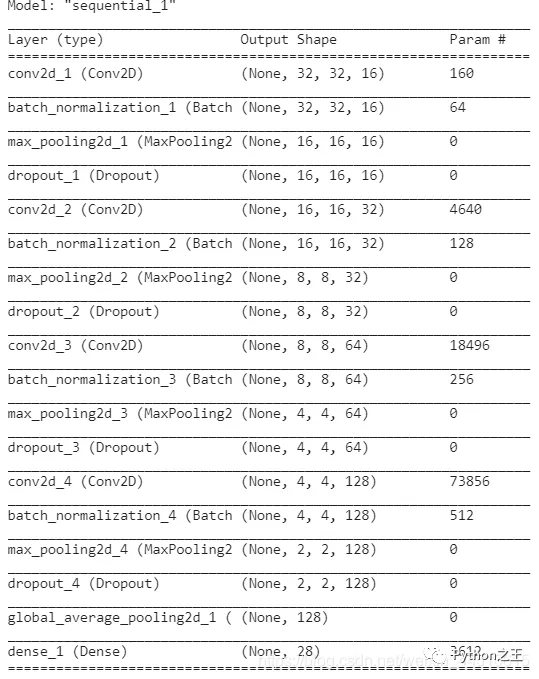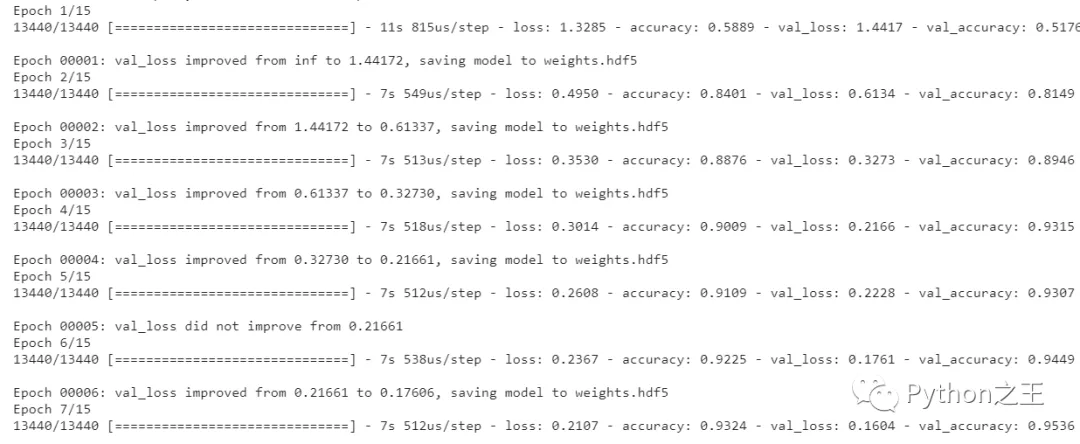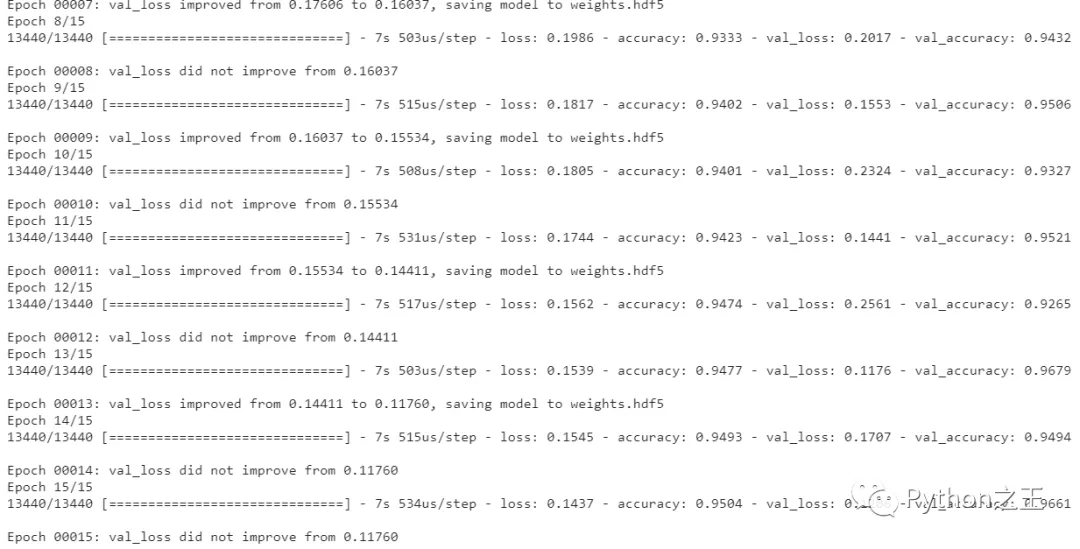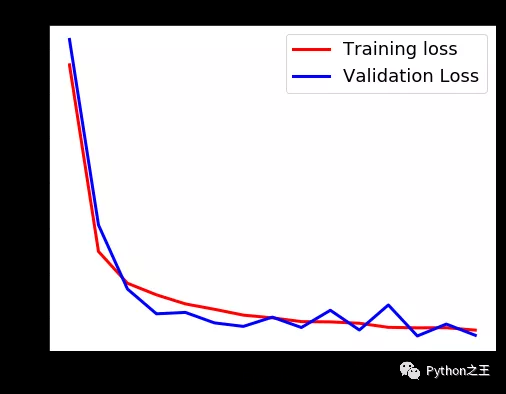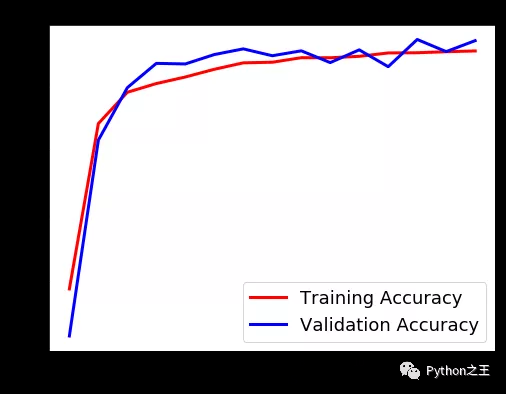教你使用TensorFlow2對阿拉伯語手寫字符數據集進行識別
在本教程中,我們將使用 TensorFlow (Keras API) 實現一個用于多分類任務的深度學習模型,該任務需要對阿拉伯語手寫字符數據集進行識別。
數據集下載地址:https://www.kaggle.com/mloey1/ahcd1
數據集介紹
該數據集由 60 名參與者書寫的16,800 個字符組成,年齡范圍在 19 至 40 歲之間,90% 的參與者是右手。
每個參與者在兩種形式上寫下每個字符(從“alef”到“yeh”)十次,如圖 7(a)和 7(b)所示。表格以 300 dpi 的分辨率掃描。使用 Matlab 2016a 自動分割每個塊以確定每個塊的坐標。該數據庫分為兩組:訓練集(每類 13,440 個字符到 480 個圖像)和測試集(每類 3,360 個字符到 120 個圖像)。數據標簽為1到28個類別。在這里,所有數據集都是CSV文件,表示圖像像素值及其相應標簽,并沒有提供對應的圖片數據。
導入模塊
- import numpy as np
- import pandas as pd
- #允許對dataframe使用display()
- from IPython.display import display
- # 導入讀取和處理圖像所需的庫
- import csv
- from PIL import Image
- from scipy.ndimage import rotate
讀取數據
- # 訓練數據images
- letters_training_images_file_path = "../input/ahcd1/csvTrainImages 13440x1024.csv"
- # 訓練數據labels
- letters_training_labels_file_path = "../input/ahcd1/csvTrainLabel 13440x1.csv"
- # 測試數據images和labels
- letters_testing_images_file_path = "../input/ahcd1/csvTestImages 3360x1024.csv"
- letters_testing_labels_file_path = "../input/ahcd1/csvTestLabel 3360x1.csv"
- # 加載數據
- training_letters_images = pd.read_csv(letters_training_images_file_path, header=None)
- training_letters_labels = pd.read_csv(letters_training_labels_file_path, header=None)
- testing_letters_images = pd.read_csv(letters_testing_images_file_path, header=None)
- testing_letters_labels = pd.read_csv(letters_testing_labels_file_path, header=None)
- print("%d個32x32像素的訓練阿拉伯字母圖像。" %training_letters_images.shape[0])
- print("%d個32x32像素的測試阿拉伯字母圖像。" %testing_letters_images.shape[0])
- training_letters_images.head()
13440個32x32像素的訓練阿拉伯字母圖像。3360個32x32像素的測試阿拉伯字母圖像。
查看訓練數據的head
- np.unique(training_letters_labels)
- array([ 1, 2, 3, 4, 5, 6, 7, 8, 9, 10, 11, 12, 13, 14, 15, 16, 17,18, 19, 20, 21, 22, 23, 24, 25, 26, 27, 28], dtype=int32)
下面需要將csv值轉換為圖像,我們希望展示對應圖像的像素值圖像。
- def convert_values_to_image(image_values, display=False):
- image_array = np.asarray(image_values)
- image_array = image_array.reshape(32,32).astype('uint8')
- # 原始數據集被反射,因此我們將使用np.flip翻轉它,然后通過rotate旋轉,以獲得更好的圖像。
- image_array = np.flip(image_array, 0)
- image_array = rotate(image_array, -90)
- new_image = Image.fromarray(image_array)
- if display == True:
- new_image.show()
- return new_image
- convert_values_to_image(training_letters_images.loc[0], True)
這是一個字母f。
下面,我們將進行數據預處理,主要進行圖像標準化,我們通過將圖像中的每個像素除以255來重新縮放圖像,標準化到[0,1]
- training_letters_images_scaled = training_letters_images.values.astype('float32')/255
- training_letters_labels = training_letters_labels.values.astype('int32')
- testing_letters_images_scaled = testing_letters_images.values.astype('float32')/255
- testing_letters_labels = testing_letters_labels.values.astype('int32')
- print("Training images of letters after scaling")
- print(training_letters_images_scaled.shape)
- training_letters_images_scaled[0:5]
輸出如下
- Training images of letters after scaling
- (13440, 1024)
從標簽csv文件我們可以看到,這是一個多類分類問題。下一步需要進行分類標簽編碼,建議將類別向量轉換為矩陣類型。
輸出形式如下:將1到28,變成0到27類別。從“alef”到“yeh”的字母有0到27的分類號。to_categorical就是將類別向量轉換為二進制(只有0和1)的矩陣類型表示
在這里,我們將使用keras的一個熱編碼對這些類別值進行編碼。
一個熱編碼將整數轉換為二進制矩陣,其中數組僅包含一個“1”,其余元素為“0”。
- from keras.utils import to_categorical
- # one hot encoding
- number_of_classes = 28
- training_letters_labels_encoded = to_categorical(training_letters_labels-1, num_classes=number_of_classes)
- testing_letters_labels_encoded = to_categorical(testing_letters_labels-1, num_classes=number_of_classes)
- # (13440, 1024)
下面將輸入圖像重塑為32x32x1,因為當使用TensorFlow作為后端時,Keras CNN需要一個4D數組作為輸入,并帶有形狀(nb_samples、行、列、通道)
其中 nb_samples對應于圖像(或樣本)的總數,而行、列和通道分別對應于每個圖像的行、列和通道的數量。
- # reshape input letter images to 32x32x1
- training_letters_images_scaled = training_letters_images_scaled.reshape([-1, 32, 32, 1])
- testing_letters_images_scaled = testing_letters_images_scaled.reshape([-1, 32, 32, 1])
- print(training_letters_images_scaled.shape, training_letters_labels_encoded.shape, testing_letters_images_scaled.shape, testing_letters_labels_encoded.shape)
- # (13440, 32, 32, 1) (13440, 28) (3360, 32, 32, 1) (3360, 28)
因此,我們將把輸入圖像重塑成4D張量形狀(nb_samples,32,32,1),因為我們圖像是32x32像素的灰度圖像。
- #將輸入字母圖像重塑為32x32x1
- training_letters_images_scaled = training_letters_images_scaled.reshape([-1, 32, 32, 1])
- testing_letters_images_scaled = testing_letters_images_scaled.reshape([-1, 32, 32, 1])
- print(training_letters_images_scaled.shape, training_letters_labels_encoded.shape, testing_letters_images_scaled.shape, testing_letters_labels_encoded.shape)
設計模型結構
- from keras.models import Sequential
- from keras.layers import Conv2D, MaxPooling2D, GlobalAveragePooling2D, BatchNormalization, Dropout, Dense
- def create_model(optimizer='adam', kernel_initializer='he_normal', activation='relu'):
- # create model
- model = Sequential()
- model.add(Conv2D(filters=16, kernel_size=3, padding='same', input_shape=(32, 32, 1), kernel_initializer=kernel_initializer, activation=activation))
- model.add(BatchNormalization())
- model.add(MaxPooling2D(pool_size=2))
- model.add(Dropout(0.2))
- model.add(Conv2D(filters=32, kernel_size=3, padding='same', kernel_initializer=kernel_initializer, activation=activation))
- model.add(BatchNormalization())
- model.add(MaxPooling2D(pool_size=2))
- model.add(Dropout(0.2))
- model.add(Conv2D(filters=64, kernel_size=3, padding='same', kernel_initializer=kernel_initializer, activation=activation))
- model.add(BatchNormalization())
- model.add(MaxPooling2D(pool_size=2))
- model.add(Dropout(0.2))
- model.add(Conv2D(filters=128, kernel_size=3, padding='same', kernel_initializer=kernel_initializer, activation=activation))
- model.add(BatchNormalization())
- model.add(MaxPooling2D(pool_size=2))
- model.add(Dropout(0.2))
- model.add(GlobalAveragePooling2D())
- #Fully connected final layer
- model.add(Dense(28, activation='softmax'))
- # Compile model
- model.compile(loss='categorical_crossentropy', metrics=['accuracy'], optimizer=optimizer)
- return model
「模型結構」
- 第一隱藏層是卷積層。該層有16個特征圖,大小為3×3和一個激活函數,它是relu。這是輸入層,需要具有上述結構的圖像。
- 第二層是批量標準化層,它解決了特征分布在訓練和測試數據中的變化,BN層添加在激活函數前,對輸入激活函數的輸入進行歸一化。這樣解決了輸入數據發生偏移和增大的影響。
- 第三層是MaxPooling層。最大池層用于對輸入進行下采樣,使模型能夠對特征進行假設,從而減少過擬合。它還減少了參數的學習次數,減少了訓練時間。
- 下一層是使用dropout的正則化層。它被配置為隨機排除層中20%的神經元,以減少過度擬合。
- 另一個隱藏層包含32個要素,大小為3×3和relu激活功能,從圖像中捕捉更多特征。
- 其他隱藏層包含64和128個要素,大小為3×3和一個relu激活功能,
- 重復三次卷積層、MaxPooling、批處理規范化、正則化和* GlobalAveragePooling2D層。
- 最后一層是具有(輸出類數)的輸出層,它使用softmax激活函數,因為我們有多個類。每個神經元將給出該類的概率。
- 使用分類交叉熵作為損失函數,因為它是一個多類分類問題。使用精確度作為衡量標準來提高神經網絡的性能。
- model = create_model(optimizer='Adam', kernel_initializer='uniform', activation='relu')
- model.summary()
「Keras支持在Keras.utils.vis_utils模塊中繪制模型,該模塊提供了使用graphviz繪制Keras模型的實用函數」
- import pydot
- from keras.utils import plot_model
- plot_model(model, to_file="model.png", show_shapes=True)
- from IPython.display import Image as IPythonImage
- display(IPythonImage('model.png'))
訓練模型,使用batch_size=20來訓練模型,對模型進行15個epochs階段的訓練。
- from keras.callbacks import ModelCheckpoint
- # 使用檢查點來保存稍后使用的模型權重。
- checkpointer = ModelCheckpoint(filepath='weights.hdf5', verbose=1, save_best_only=True)
- history = model.fit(training_letters_images_scaled, training_letters_labels_encoded,validation_data=(testing_letters_images_scaled,testing_letters_labels_encoded),epochs=15, batch_size=20, verbose=1, callbacks=[checkpointer])
訓練結果如下所示:
最后Epochs繪制損耗和精度曲線。
- import matplotlib.pyplot as plt
- def plot_loss_accuracy(history):
- # Loss
- plt.figure(figsize=[8,6])
- plt.plot(history.history['loss'],'r',linewidth=3.0)
- plt.plot(history.history['val_loss'],'b',linewidth=3.0)
- plt.legend(['Training loss', 'Validation Loss'],fontsize=18)
- plt.xlabel('Epochs ',fontsize=16)
- plt.ylabel('Loss',fontsize=16)
- plt.title('Loss Curves',fontsize=16)
- # Accuracy
- plt.figure(figsize=[8,6])
- plt.plot(history.history['accuracy'],'r',linewidth=3.0)
- plt.plot(history.history['val_accuracy'],'b',linewidth=3.0)
- plt.legend(['Training Accuracy', 'Validation Accuracy'],fontsize=18)
- plt.xlabel('Epochs ',fontsize=16)
- plt.ylabel('Accuracy',fontsize=16)
- plt.title('Accuracy Curves',fontsize=16)
- plot_loss_accuracy(history)
「加載具有最佳驗證損失的模型」
- # 加載具有最佳驗證損失的模型
- model.load_weights('weights.hdf5')
- metrics = model.evaluate(testing_letters_images_scaled, testing_letters_labels_encoded, verbose=1)
- print("Test Accuracy: {}".format(metrics[1]))
- print("Test Loss: {}".format(metrics[0]))
輸出如下:
- 3360/3360 [==============================] - 0s 87us/step
- Test Accuracy: 0.9678571224212646
- Test Loss: 0.11759862171020359
打印混淆矩陣。
- from sklearn.metrics import classification_report
- def get_predicted_classes(model, data, labels=None):
- image_predictions = model.predict(data)
- predicted_classes = np.argmax(image_predictions, axis=1)
- true_classes = np.argmax(labels, axis=1)
- return predicted_classes, true_classes, image_predictions
- def get_classification_report(y_true, y_pred):
- print(classification_report(y_true, y_pred))
- y_pred, y_true, image_predictions = get_predicted_classes(model, testing_letters_images_scaled, testing_letters_labels_encoded)
- get_classification_report(y_true, y_pred)
輸出如下:
- precision recall f1-score support
- 0 1.00 0.98 0.99 120
- 1 1.00 0.98 0.99 120
- 2 0.80 0.98 0.88 120
- 3 0.98 0.88 0.93 120
- 4 0.99 0.97 0.98 120
- 5 0.92 0.99 0.96 120
- 6 0.94 0.97 0.95 120
- 7 0.94 0.95 0.95 120
- 8 0.96 0.88 0.92 120
- 9 0.90 1.00 0.94 120
- 10 0.94 0.90 0.92 120
- 11 0.98 1.00 0.99 120
- 12 0.99 0.98 0.99 120
- 13 0.96 0.97 0.97 120
- 14 1.00 0.93 0.97 120
- 15 0.94 0.99 0.97 120
- 16 1.00 0.93 0.96 120
- 17 0.97 0.97 0.97 120
- 18 1.00 0.93 0.96 120
- 19 0.92 0.95 0.93 120
- 20 0.97 0.93 0.94 120
- 21 0.99 0.96 0.97 120
- 22 0.99 0.98 0.99 120
- 23 0.98 0.99 0.99 120
- 24 0.95 0.88 0.91 120
- 25 0.94 0.98 0.96 120
- 26 0.95 0.97 0.96 120
- 27 0.98 0.99 0.99 120
- accuracy 0.96 3360
- macro avg 0.96 0.96 0.96 3360
- ghted avg 0.96 0.96 0.96 3360
最后繪制隨機幾個相關預測的圖片
- indices = np.random.randint(0, testing_letters_labels.shape[0], size=49)
- y_pred = np.argmax(model.predict(training_letters_images_scaled), axis=1)
- for i, idx in enumerate(indices):
- plt.subplot(7,7,i+1)
- image_array = training_letters_images_scaled[idx][:,:,0]
- image_array = np.flip(image_array, 0)
- image_array = rotate(image_array, -90)
- plt.imshow(image_array, cmap='gray')
- plt.title("Pred: {} - Label: {}".format(y_pred[idx], (training_letters_labels[idx] -1)))
- plt.xticks([])
- plt.yticks([])
- plt.show()














